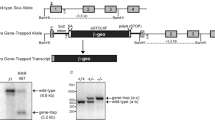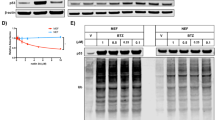Abstract
The p53 protein can inhibit cell cycling or induce apoptosis, and is thus a critical regulator of tumorigenesis1. This protein is negatively regulated by a physical interaction with MDM2, an E3 ubiquitin ligase2,3,4. This interaction is critical for cell viability; loss of Mdm2 causes cell death in vitro and in vivo in a p53-dependent manner5,6,7. The recently discovered8 MDM2-related protein MDM4 (also known as MDMX) has some of the same properties as MDM2. MDM4 binds and inhibits p53 transcriptional activity in vitro. Unlike MDM2, however, MDM4 does not cause nuclear export or degradation of p53 (refs. 9,10). To study MDM4 function in vivo, we deleted Mdm4 in mice. Mdm4-null mice died at 7.5–8.5 dpc, owing to loss of cell proliferation and not induction of apoptosis. To assess the importance of p53 in the death of Mdm4−/− embryos, we crossed in the Trp53-null allele. The loss of Trp53 completely rescued the Mdm4−/− embryonic lethality. Thus, MDM2 and MDM4 are nonoverlapping critical regulators of p53 in vivo. These data define a new pathway of p53 regulation and raise the possibility that increased MDM4 levels and the resulting inactivation of p53 contribute to the development of human tumors.
This is a preview of subscription content, access via your institution
Access options
Subscribe to this journal
Receive 12 print issues and online access
$209.00 per year
only $17.42 per issue
Buy this article
- Purchase on Springer Link
- Instant access to full article PDF
Prices may be subject to local taxes which are calculated during checkout






Similar content being viewed by others
References
Vogelstein, B., Lane, D. & Levine, A.J. Surfing the p53 network. Nature 408, 307–310 (2000).
Haupt, Y., Maya, R., Kazaz, A. & Oren, M. Mdm2 promotes the rapid degradation of p53. Nature 387, 296–299 (1997).
Kubbutat, M.H., Jones, S.N. & Vousden, K.H. Regulation of p53 stability by mdm2. Nature 387, 299–303 (1997).
Honda, R., Tanaka, H. & Yasuda, H. Oncoprotein MDM2 is a ubiquitin ligase E3 for tumor suppressor p53. FEBS Lett. 420, 25–27 (1997).
Montes de Oca Luna, R., Wagner, D.S. & Lozano, G. Rescue of early embryonic lethality in mdm2-deficient mice by deletion of p53. Nature 378, 203–206 (1995).
Jones, S.N., Roe, A.E., Donehower, L.A. & Bradley, A. Rescue of embryonic lethality in Mdm2-deficient mice by absence of p53. Nature 378, 206–208 (1995).
de Rozieres, S., Maya, R., Oren, M. & Lozano, G. The loss of mdm2 induces p53- mediated apoptosis. Oncogene 19, 1691–1697 (2000).
Shvarts A. et al. MDMX: a novel p53-binding protein with some functional properties of MDM2. EMBO J. 15, 5349–5357 (1996).
Jackson, M.W. & Berberich, S.J. Mdmx protects p53 from Mdm2-mediated degradation. Mol. Cell. Biol. 20, 1001–1007 (2000).
Stad, R. et al. Hdmx stabilizes Mdm2 and p53. J. Biol Chem. 275, 28039–28044 (2000).
Parant, J.M., Reinke, V., Mims, B. & Lozano, G. Organization, expression, and localization of the murine mdmx gene and pseudogene. Gene 270, 277–283 (2001).
Manova, K. et al. Apoptosis in mouse embryos: elevated levels in pregastrulae and in the distal anterior region of gastrulae of normal and mutant mice. Dev. Dyn. 213, 293–308 (1998).
Jacks, T. et al. Tumor spectrum analysis in p53 mutant mice. Curr. Biol. 4, 1–7 (1994).
McMahon, A.P. & Bradley A. The Wnt-1 (int-1) proto-oncogene is required for development of a large region of the mouse brain. Cell 62, 1073–1085 (1990).
Wilkinson D.G. (ed) In situ Hybridization: A Practical Approach. 75–83 (IRL Press, Oxford, 1998).
Gavrieli, Y., Sherman, Y. & Ben-Sasson, S.A. Identification of programmed cell death in situ via specific labeling of nuclear DNA fragmentation. J. Cell. Biol. 119, 493–501 (1992).
Oliner J.D., Pietenpol, J.A., Thiagalingam, S., Gyuris, J., Kinzler, K.W. & Vogelstein, B. Oncoprotein MDM2 conceals the activation domain of tumour suppressor p53. Nature 362, 857–860 (1993).
Ramos, Y.F., Stad, R., Attema, J., Peltenburg, L.T., van der Eb, A.J. & Jochemsen, A.G. Aberrant expression of HDMX proteins in tumor cells correlates with wild-type p53. Cancer Res. 61, 1839–1842 (2001).
Acknowledgements
We thank R. Behringer, S. Evans and L. Amelse for critical review of the manuscript, and H. Eberspaecher and M. Kielman for technical advice. G.L. is supported by grants from the National Institutes of Health. N.A.L. is supported by a grant from the Association for International Cancer Research.
Author information
Authors and Affiliations
Corresponding author
Rights and permissions
About this article
Cite this article
Parant, J., Chavez-Reyes, A., Little, N. et al. Rescue of embryonic lethality in Mdm4-null mice by loss of Trp53 suggests a nonoverlapping pathway with MDM2 to regulate p53. Nat Genet 29, 92–95 (2001). https://doi.org/10.1038/ng714
Received:
Accepted:
Published:
Issue Date:
DOI: https://doi.org/10.1038/ng714
This article is cited by
-
Tissue specificity and spatio-temporal dynamics of the p53 transcriptional program
Cell Death & Differentiation (2023)
-
MDMX elevation by a novel Mdmx–p53 interaction inhibitor mitigates neuronal damage after ischemic stroke
Scientific Reports (2022)
-
PPM1D suppresses p53-dependent transactivation and cell death by inhibiting the Integrated Stress Response
Nature Communications (2022)
-
MDMX is essential for the regulation of p53 protein levels in the absence of a functional MDM2 C-terminal tail
BMC Molecular and Cell Biology (2021)
-
Structural basis for DNA damage-induced phosphoregulation of MDM2 RING domain
Nature Communications (2020)



